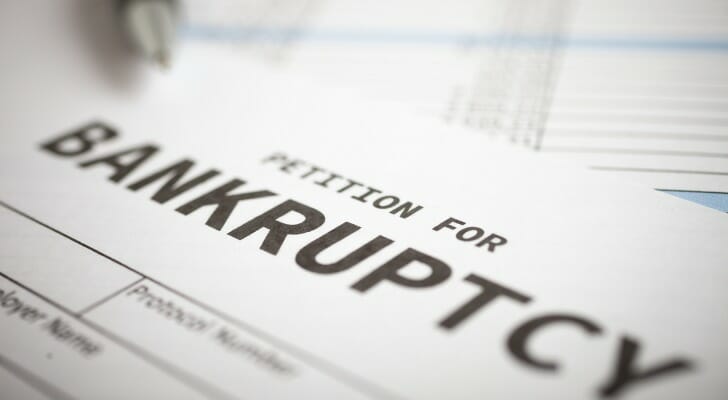Bankruptcy is a way for an individual or business to have their debts legally discharged in the event that they cannot pay them. For example, if your home is being foreclosed upon or your debts have built up to the point that they’re unmanageable, bankruptcy may be a good option. While bankruptcy has advantages, it will trigger serious consequences, such as long-term damage to your credit score. There are different kinds of bankruptcy, and some alternatives to filing for bankruptcy, so be sure to pick the option that’s best for you. A financial advisor can help you handle bankruptcy or liquidation – and also, in some cases, avoid such an outcome.
What Is Bankruptcy?
When an individual or organization files for bankruptcy, they are essentially admitting that their debts are now at the point where they cannot be repaid. To determine whether or not this is true, the court will review the debtor’s assets and liabilities and formulate a plan of action based on their findings. In some cases, the debtor may need to repay at least part of the outstanding debt. A bankruptcy proceeding is a legal, so it is handled by federal courts.
There are several different types of bankruptcy, with each other varying slightly from the others. While bankruptcies can wreak havoc on the debtor’s credit scores and make future loans difficult to come by, it does provide a way out for those who are unable to repay certain debts.
Before you even begin filing, consider first reaching out to your creditors to see if there’s anything that can be done. Since a bankruptcy can stay on your credit report for quite some time, private negotiation can help avoid its downsides while achieving a similar result. Loan forbearance and modification are two other potential solutions that don’t have to involve a bankruptcy declaration.
What Are the Different Types of Bankruptcy?
While options for businesses are more varied, individuals typically file for either Chapter 7 or Chapter 13 bankruptcy. Each different version of bankruptcy offers its own advantages and disadvantages. For example, Chapter 7 focuses on the debtor liquidating some of their assets to help pay back debts. Other types of bankruptcy help the debtor reorganize their debts.
Chapter 7
Chapter 7 bankruptcy involves liquidating your qualifying assets in order to pay your creditors back at least partially. Some assets are protected from liquidation, such as partial equity in a home or a car, Social Security benefits, retirement accounts and more. In turn, a trustee will take stock of your eligible assets and liquidate them, giving the profits to creditors.
Ideally, you won’t be in any debt after the Chapter 7 liquidation process, even if your assets don’t cover the full amount of your debts. It’s important to note, however, that certain exempt debts, like student loans and taxes, cannot be discharged.
In order to file for Chapter 7 bankruptcy, you must also undergo a means test to determine your eligibility for filing. This test looks at your income over the six-month period prior to filing and compares it to the median income in your state. Those who earn less than the state median income are eligible for Chapter 7. The 122A-2 form helps to determine your eligibility. Chapter 7 bankruptcies stay on your credit report for 10 years.
Chapter 13
Chapter 7 is typically reserved for those who aren’t as financially well-off, but Chapter 13 bankruptcy is a bit different. For this, the debtor will retain all of their assets, but agree to repay their debts over a three- to five-year period. Chapter 13 bankruptcies stay on your credit report for seven years.
Other Types of Bankruptcy
There are four other types of bankruptcy though most apply to businesses or unique sets of circumstances. Here’s a quick overview of each:
- Chapter 9: This is specifically designed for city governments and agencies that are encountering financial issues.
- Chapter 11: This business-centric type of bankruptcy allows companies to reorganize large sets of debt.
- Chapter 12: This is available exclusively to family farmers and fisherman.
- Chapter 15: This is typically filed by foreign companies that operate in the U.S., but have debt proceedings pending in other countries.
How to File for Bankruptcy

When an individual or organization is considering filing for bankruptcy, there are several steps that must be followed. Although not all bankruptcies are the same, each of their processes follow a similar structure. Anyone considering filing for bankruptcy should first talk to a qualified attorney. While you aren’t legally required to work with a lawyer to file, it’s strongly recommended due to the legal and financial implications of such a proceeding.
Before you file any paperwork, get together detailed listings of your financial assets and liabilities. Not only will doing this shed light on whether you really need to file or not, but it will also makes things much easier when you get to court.
The entire bankruptcy process is handled at the federal level. As a result, you’ll likely need to have a session with a Department of Justice-approved credit counseling organization about six months before your proceeding. This time will help you devise a budget plan and discuss alternatives. There is a fee for this meeting, but it’s waived for anyone who can’t afford it.
Once you file your petition for bankruptcy, your court-appointed trustee will see to it that your debts are repaid within a certain time frame. When this happens, the court also issues what’s called an “automatic stay,” which prevents your creditors from seizing additional assets to cover your debts.
Once your debts are officially discharged, your creditors have no more legal standing to hold you liable for them. Chapter 7 bankruptcies typically see discharges happen after six months, whereas Chapter 13 bankruptcies discharge debts after the repayment plan is complete.
What Are the Consequences of Filing for Bankruptcy?
One of the most significant impacts that bankruptcy can be seen on the debtor’s credit profile. Bankruptcies are a huge red flag to potential lenders, and since they remain on your credit report for up to a decade, you’ll be forced to deal with that fallout for quite a while. As a result, you may find it difficult or impossible to get certain lines of credit, such as credit cards, mortgages or car loans.
While a bankruptcy will stay on your credit report for years, you can rebuild your profile and score by using credit responsibly. In turn, you may need to use instruments like secured credit cards at first. If you’re smart with your credit lines, your profile will continue to improve even if your filing is still visible.
Bottom Line

Filing for bankruptcy can be a difficult decision. In the short term, it will hurt your credit score and could cause you to lose assets that you don’t want to part with. However, if you determine it’s the best course of action, it can help to settle your debts and move on. Just make sure to familiarize yourself with all the options before you file, as there are major implications for such a decision.
Tips for Managing Your Finances
- A financial advisor can help you navigate the impacts of debt on your finances. If you don’t have a financial advisor yet, finding one doesn’t have to be hard. SmartAsset’s free tool matches you with up to three vetted financial advisors who serve your area, and you can interview your advisor matches at no cost to decide which one is right for you. If you’re ready to find an advisor who can help you achieve your financial goals, get started now.
- Looking for a credit card to help you build your credit? Check out SmartAsset’s lists of the best secured credit cards and the best credit cards for bad credit.
Photo credit: ©iStock.com/fizkes, ©iStock.com/ljubaphoto, ©iStock.com/Minerva Studio
